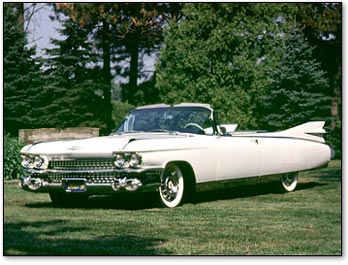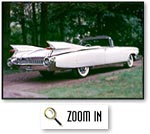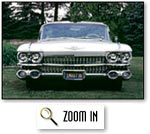May 1999

Cadillac Eldorado Biarritz Convertible
Cadillac Division, General Motors Corp., Detroit, MI
Date: 1959
ID: 86.48.1
The 1959 Cadillac has come to symbolize all that was good and bad about America in the 1950s: exuberance, self-confidence, abundance; and excess, self-indulgence, and waste of resources.
Ironically, the story of the 1959 Cadillac begins in the styling studios of Chrysler Corporation. For the 1957 model year Chrysler design chief Virgil Exner created a startling group of cars: big, with sweeping tail fins, but at the same time low and fleet-looking, with thin rooflines and plenty of glass. Exner called the new designs the Forward Look. In August of 1956 GM designer Chuck Jordan saw some of these cars in a lot behind the Chrysler plant on Mound Road in Warren, Michigan. He returned with other GM designers, who realized that their own 1957 models were heavy and over-trimmed by comparison. It was too late to do much with those cars, or even 1958s, but the 1959s could be changed. It happened that General Motors' styling chief Harley Earl was in Europe, and his assistant Bill Mitchell had full authority in Earl's absence. Thus began a quiet revolution, as designers abandoned the rounded forms favored by Earl for the cleaner, sharper lines favored by Mitchell (and Exner).
|
 |
The most memorable design elements of the 1959 Cadillac are the soaring tail fins, the tallest to ever adorn any production car. Fins first appeared on Cadillacs in 1948, and GM tradition has it that they were inspired by the twin tails of the World War II P-38 fighter plane. The fins remained modest little extensions until 1957, when they grew higher and longer. They were equally prominent in 1958, became virtual self-caricatures in 1959, and subsided to more reasonable proportions in 1960. |
|
Fins were not the only aircraft design elements transferred to automobiles. In the 1930s, car stylists began adopting the rounded shapes of propeller-driven airplanes like the DC-3. Exner's 1957 cars are the first to exhibit the sharper, more angular shapes of jet aircraft. The 1959 Cadillac is full of jet styling cues. The tail fins themselves, with their sharp vee-shaped trailing edges, recall the swept-wings of jet aircraft. The twin taillights mounted on each fin remind one of jet engine exhaust. The beltline of the car sweeps down to meet back-up light pods in the rear bumper that also resemble jet exhausts. At the front of the car, the dual parking lights positioned under each set of headlights resemble B-52 jet bomber air intakes. Finally, the light, airy greenhouses on the sedans and coupes simulate jet fighter canopies. |  |
Today we have forgotten just how big some of these 1950s cars actually were. Here is how the 1959 Cadillac stacks up against two current behemoths, the 2000 Ford Excursion and 2000 Chevrolet Suburban sport utility vehicles:
|
1959 Cadillac |
2000 Excursion |
2000 Suburban |
| Length |
225" |
226.7" |
219.3" |
| Wheelbase |
130" |
137.1" |
130" |
| Width |
81.1" |
80" |
78.8" |
| Height |
54.4" |
79.5" |
78.8" |
| Weight |
5,060 lbs. |
7,047 lbs. |
5,171 lbs. |
The people who bought the large, powerful, chrome-encrusted cars of the 1950s are the people Tom Brokaw has recently described as The Greatest Generation. They had survived the Great Depression and won World War II. They knew about hardship, deprivation, and sacrifice. They believed that they deserved some rewards for all their troubles, and the economic expansion of the post-war era gave them the opportunity to acquire those rewards. The 1959 Cadillac represents a type of car that had never been built before the 1950s, and likely will never be built again.
|
[ Pic of the Month ] [ Pic Archive ]
|

